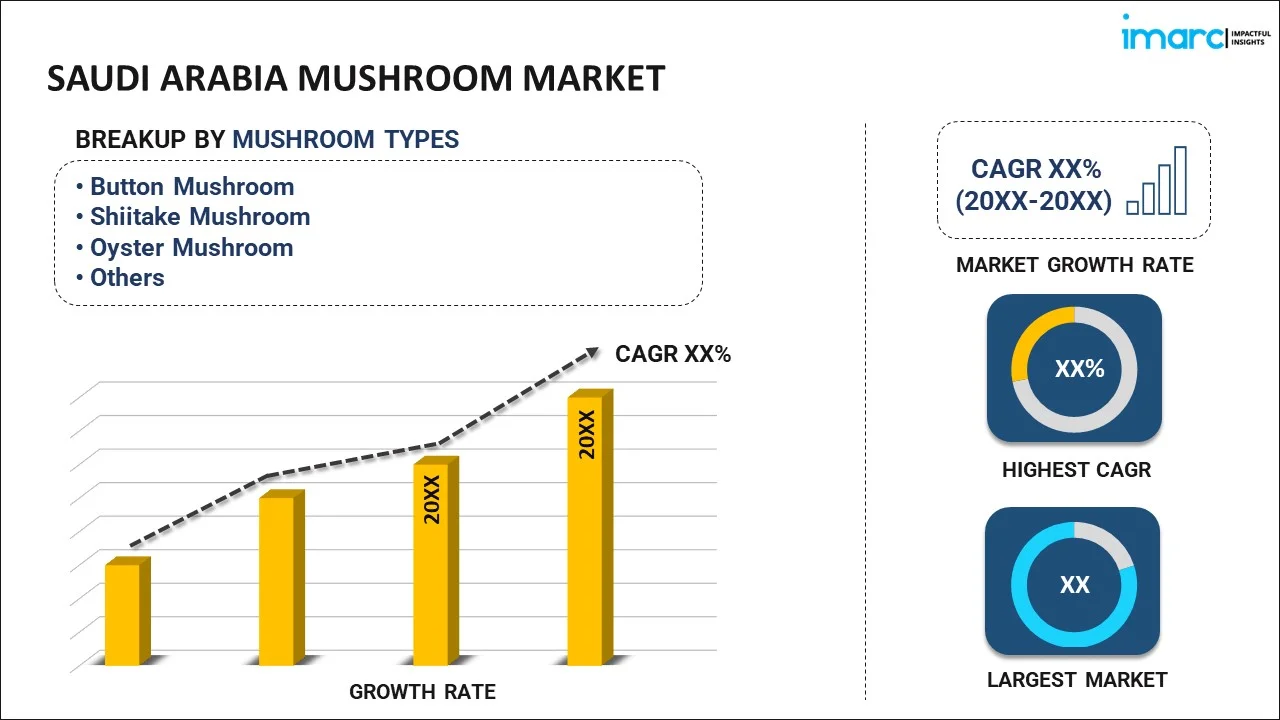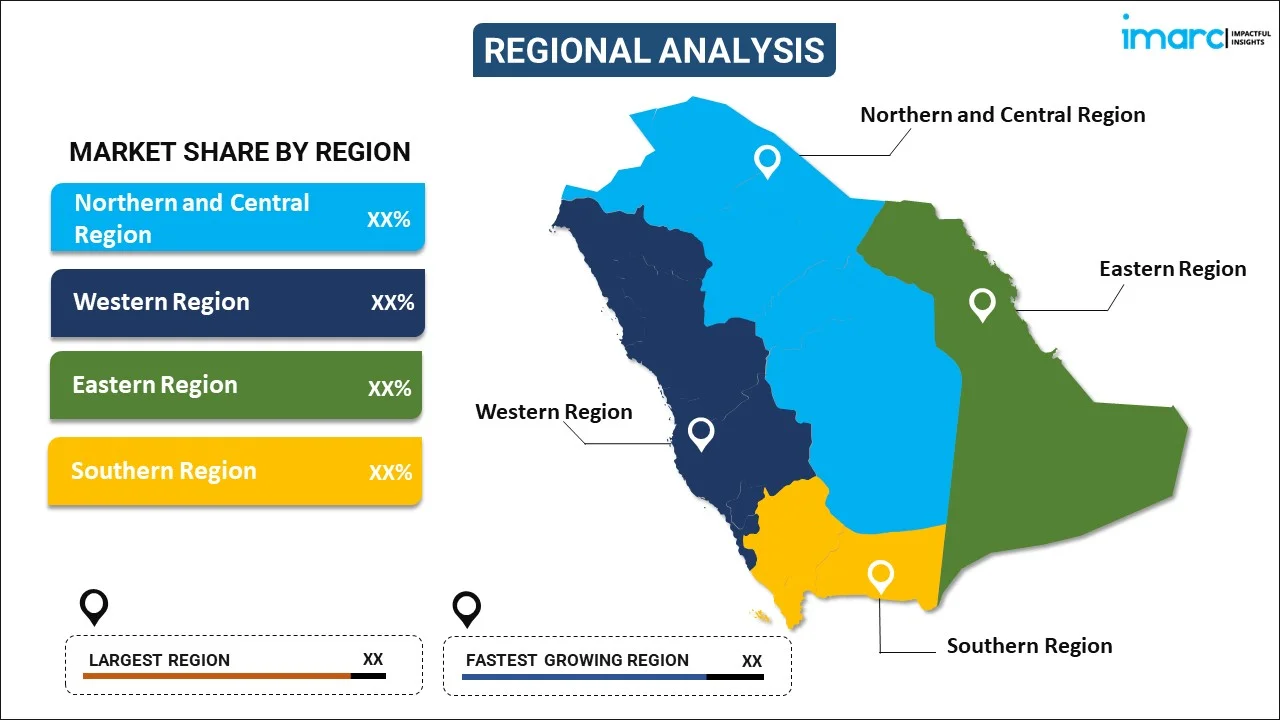
Saudi Arabia Mushroom Market Report by Mushroom Type (Button Mushroom, Shiitake Mushroom, Oyster Mushroom, and Others), Form (Fresh Mushroom, Canned Mushroom, Dried Mushroom, and Others), Distribution Channel (Supermarkets and Hypermarkets, Grocery Stores, Online Stores, and Others), End Use (Food Processing Industry, Food Service Sector, Direct Consumption, and Others), and Region 2025-2033
Market Overview:
Saudi Arabia mushroom market size reached USD 666.5 Million in 2024. Looking forward, IMARC Group expects the market to reach USD 1,411.8 Million by 2033, exhibiting a growth rate (CAGR) of 8.7% during 2025-2033. The increasing innovations in cultivation techniques, such as controlled environment agriculture, vertical farming, and other sustainable practices, that can increase mushroom production efficiency and reduce environmental impact, are driving the market.
|
Report Attribute
|
Key Statistics
|
|---|---|
|
Base Year
|
2024
|
|
Forecast Years
|
2025-2033
|
|
Historical Years
|
2019-2024
|
| Market Size in 2024 | USD 666.5 Million |
| Market Forecast in 2033 | USD 1,411.8 Million |
| Market Growth Rate 2025-2033 | 8.7% |
Mushrooms are fungi that play diverse roles in ecosystems and hold culinary and medicinal significance. Comprising a vast array of species, mushrooms feature distinctive cap and stem structures, with reproductive structures called spore-bearing gills. These fungi thrive in various environments, from forests to grasslands. While some mushrooms are edible and enjoyed in cuisines, others are toxic and must be approached with caution. Certain mushroom varieties have been utilized for centuries in traditional medicine for their potential health benefits. Mushrooms contribute to nutrient cycling by breaking down organic matter, playing a crucial role in ecological systems. Additionally, they form symbiotic relationships with plant roots, enhancing nutrient absorption. Recent research highlights their potential applications in areas like environmental remediation and as a sustainable source of protein. Despite their diverse forms and functions, mushrooms collectively showcase the intricate interplay between nature, human culture, and scientific exploration.
Saudi Arabia Mushroom Market Trends:
The mushroom market in Saudi Arabia is experiencing robust growth, primarily driven by the increasing consumer awareness of the health benefits associated with mushroom consumption. Moreover, the rising trend of plant-based diets has propelled the demand for mushrooms as a nutritious and versatile meat substitute. Furthermore, the expanding culinary landscape has led to a surge in the incorporation of various mushroom varieties in diverse dishes. Additionally, the growing recognition of mushrooms for their medicinal properties has spurred R&D activities, contributing to an expanded product portfolio. In parallel, advancements in cultivation techniques and technology have enhanced the efficiency of mushroom farming, leading to increased production and a more sustainable supply chain. Furthermore, the environmental sustainability aspect of mushroom cultivation, characterized by its low carbon footprint and ability to thrive on organic waste, resonates well with environmentally conscious consumers, thereby fueling market growth. As a result, a confluence of health, culinary, and sustainability factors collectively propels the mushroom market forward in Saudi Arabia, marking it as a dynamic and promising industry.
Saudi Arabia Mushroom Market Segmentation:
IMARC Group provides an analysis of the key trends in each segment of the market, along with forecasts at the country level for 2025-2033. Our report has categorized the market based on mushroom type, form, distribution channel, and end use.
Mushroom Type Insights:

- Button Mushroom
- Shiitake Mushroom
- Oyster Mushroom
- Others
The report has provided a detailed breakup and analysis of the market based on the mushroom type. This includes button mushroom, shiitake mushroom, oyster mushroom, and others.
Form Insights:
- Fresh Mushroom
- Canned Mushroom
- Dried Mushroom
- Others
A detailed breakup and analysis of the market based on the form have also been provided in the report. This includes fresh mushroom, canned mushroom, dried mushroom, and others.
Distribution Channel Insights:
- Supermarkets and Hypermarkets
- Grocery Stores
- Online Stores
- Others
The report has provided a detailed breakup and analysis of the market based on the distribution channel. This includes supermarkets and hypermarkets, grocery stores, online stores, and others.
End Use Insights:
- Food Processing Industry
- Food Service Sector
- Direct Consumption
- Others
A detailed breakup and analysis of the market based on the end use have also been provided in the report. This includes food processing industry, food service sector, direct consumption, and others.
Regional Insights:

- Northern and Central Region
- Western Region
- Eastern Region
- Southern Region
The report has also provided a comprehensive analysis of all the major regional markets, which include Northern and Central Region, Western Region, Eastern Region, and Southern Region.
Competitive Landscape:
The market research report has also provided a comprehensive analysis of the competitive landscape. Competitive analysis such as market structure, key player positioning, top winning strategies, competitive dashboard, and company evaluation quadrant has been covered in the report. Also, detailed profiles of all major companies have been provided.
Saudi Arabia Mushroom Market Report Coverage:
| Report Features | Details |
|---|---|
| Base Year of the Analysis | 2024 |
| Historical Period | 2019-2024 |
| Forecast Period | 2025-2033 |
| Units | Million USD |
| Scope of the Report | Exploration of Historical Trends and Market Outlook, Industry Catalysts and Challenges, Segment-Wise Historical and Future Market Assessment:
|
| Mushroom Types Covered | Button Mushroom, Shiitake Mushroom, Oyster Mushroom, Others |
| Forms Covered | Fresh Mushroom, Canned Mushroom, Dried Mushroom, Others |
| Distribution Channels Covered | Supermarkets and Hypermarkets, Grocery Stores, Online Stores, Others |
| End Uses Covered | Food Processing Industry, Food Service Sector, Direct Consumption, Others |
| Regions Covered | Northern and Central Region, Western Region, Eastern Region, Southern Region |
| Customization Scope | 10% Free Customization |
| Post-Sale Analyst Support | 10-12 Weeks |
| Delivery Format | PDF and Excel through Email (We can also provide the editable version of the report in PPT/Word format on special request) |
Key Questions Answered in This Report:
- How has the Saudi Arabia mushroom market performed so far and how will it perform in the coming years?
- What has been the impact of COVID-19 on the Saudi Arabia mushroom market?
- What is the breakup of the Saudi Arabia mushroom market on the basis of mushroom type?
- What is the breakup of the Saudi Arabia mushroom market on the basis of form?
- What is the breakup of the Saudi Arabia mushroom market on the basis of distribution channel?
- What is the breakup of the Saudi Arabia mushroom market on the basis of end use?
- What are the various stages in the value chain of the Saudi Arabia mushroom market?
- What are the key driving factors and challenges in the Saudi Arabia mushroom?
- What is the structure of the Saudi Arabia mushroom market and who are the key players?
- What is the degree of competition in the Saudi Arabia mushroom market?
Key Benefits for Stakeholders:
- IMARC’s industry report offers a comprehensive quantitative analysis of various market segments, historical and current market trends, market forecasts, and dynamics of the Saudi Arabia mushroom market from 2019-2033.
- The research report provides the latest information on the market drivers, challenges, and opportunities in the Saudi Arabia mushroom market.
- Porter's five forces analysis assist stakeholders in assessing the impact of new entrants, competitive rivalry, supplier power, buyer power, and the threat of substitution. It helps stakeholders to analyze the level of competition within the Saudi Arabia mushroom industry and its attractiveness.
- Competitive landscape allows stakeholders to understand their competitive environment and provides an insight into the current positions of key players in the market.
Need more help?
- Speak to our experienced analysts for insights on the current market scenarios.
- Include additional segments and countries to customize the report as per your requirement.
- Gain an unparalleled competitive advantage in your domain by understanding how to utilize the report and positively impacting your operations and revenue.
- For further assistance, please connect with our analysts.
 Inquire Before Buying
Inquire Before Buying
 Speak to an Analyst
Speak to an Analyst
 Request Brochure
Request Brochure
 Request Customization
Request Customization




.webp)




.webp)












